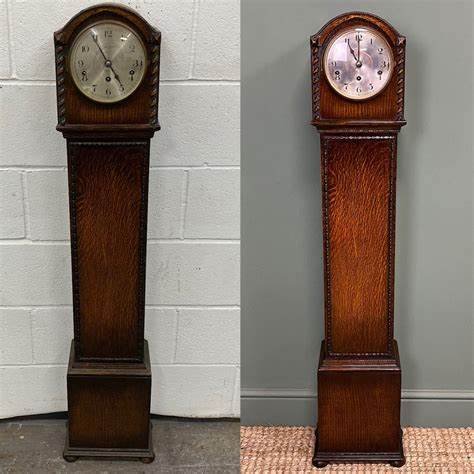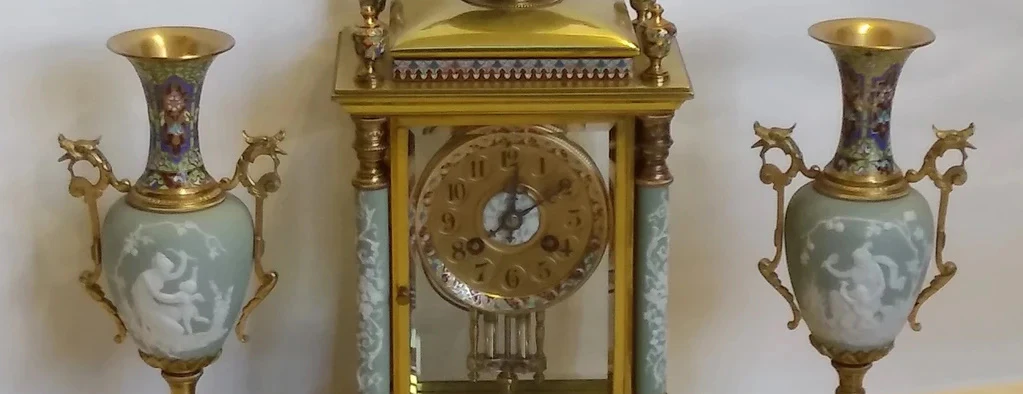Identifying a genuine antique clock from a well-crafted replica can be challenging, especially for those not well-versed in clockmaking history and techniques. Antique clocks are valued not just for their timekeeping ability but also for their craftsmanship, historical significance, and rarity. Replicas, while often skillfully made, lack the unique characteristics and history of genuine antiques. Here’s a guide to help you distinguish between the two.

Examine the Maker’s Mark and Labels
Genuine Antique Clock:
- Maker’s Mark: Authentic antique clocks typically have a maker’s mark or a signature engraved on the movement or the case. Look for well-known clockmakers such as Seiko, Howard, or Breguet.
- Labels and Tags: Original labels, tags, or inscriptions on the clock can provide clues about its authenticity. These should be consistent with the known labeling practices of the era.
Replica:
- Inaccurate Marks: Replicas might have maker’s marks that are either incorrectly placed or mimicking famous brands. The font, style, or spelling may be inconsistent with historical records.
- Modern Labels: Replicas might use modern or generic labels that lack historical accuracy.
Inspect the Movement
Genuine Antique Clock:
- Craftsmanship: Antique clock movements are often hand-crafted with intricate details. Look for signs of handwork, such as engraved gears or finely detailed mechanisms.
- Materials: Genuine antique clocks were made using high-quality materials like brass or fine woods. The movement should have a patina that indicates age.
Replica:
- Mass-Produced Parts: Replicas often use modern, mass-produced components. Check for uniformity and lack of hand-finishing.
- New Materials: Replicas may use less expensive materials that don’t age like the original high-quality materials.
Check the Construction and Design
Genuine Antique Clock:
- Construction: Antique clocks often show signs of wear and tear consistent with age. Look for natural aging, such as worn edges or patina.
- Design Elements: Authentic designs will reflect the era’s style, with period-specific details like ornate carvings or classical motifs.
Replica:
- Overly Pristine Condition: A replica may look too clean or too well-preserved compared to an authentic antique.
- Anachronistic Design: Replicas might mix design elements from different periods or styles inappropriately.
Assess the Mechanism
Genuine Antique Clock:
- Wear Patterns: Original mechanisms show signs of natural wear, such as slight scratches or discoloration. The movement should work smoothly despite age.
- Consistency with Era: The mechanism should match the technology and design of the clock’s supposed time period.
Replica:
- Smooth Mechanism: Replicas often have mechanisms that are too smooth or overly modern, lacking the subtle imperfections of age.
- Inconsistencies: Look for inconsistencies in the mechanism that may not align with historical designs.
Evaluate the Case and Materials
Genuine Antique Clock:
- Materials: Authentic cases are made from high-quality materials like solid wood, brass, or marble. The case will show signs of aging, such as minor scratches, dents, or color changes.
- Craftsmanship: Examine the quality of craftsmanship. Antique cases often have intricate detailing and finishing.
Replica:
- Modern Materials: Replicas may use synthetic materials or lower-quality wood and metals.
- Inconsistent Craftsmanship: The detailing may be less refined or inconsistent with historical craftsmanship standards.
Look for Documentation and Provenance
Genuine Antique Clock:
- Documentation: Original purchase receipts, certificates of authenticity, or historical documentation can verify authenticity.
- Provenance: Research the clock’s history and ownership. Genuine antiques often have a documented provenance.
Replica:
- Lack of Documentation: Replicas might come with vague or no documentation. Verify the provenance with reputable experts or collectors.
Consult an Expert
If you’re still unsure about a clock’s authenticity, consulting a professional antique clock expert or appraiser is the best course of action. Experts can provide a detailed examination and confirm whether a clock is genuine or a replica.
Conclusion
Spotting a genuine antique clock versus a replica requires careful examination of various factors, including maker’s marks, materials, craftsmanship, and documentation. By understanding these characteristics and consulting with experts when necessary, you can better appreciate and identify the true value of antique clocks. Whether you’re a collector or a casual enthusiast, distinguishing between real and replica can enhance your appreciation of timekeeping history and craftsmanship.





Just logged in to phlboss11login! Quick and easy! Looking forward to playing my favorite games. Sana manalo!
Been using keo188bet for a while now, and honestly, I’m happy with it. The odds are decent and the site’s easy to navigate. Give it a try if you’re into that sort of thing. Link’s right here: keo188bet
Seit dem neuen Glücksspielstaatsvertrag (GlüStV) im Jahr 2021
gelten in Deutschland strengere Vorgaben für Anbieter von Online-Glücksspielen. Es
kombiniert ein breites Angebot an Casinospielen mit Sportwetten und Live-Dealer-Tischen. Die E-Mail-Adresse lautet und es
steht auch ein Team per Live Chat bei Fragen bereit. Der Live
Chat ist im Rolletto Casino auf der Website unten rechts oder auf
Mobilgeräten über das Auswahlmenü zu finden.
Als Alternative finden Sie zudem Antworten auf viele Fragen im FAQ-Bereich, der über einen Link im unteren Bereich der Website zu finden ist.
Darunter befinden sich namhafte Unternehmen wie Play’n GO, Microgaming,
NetEnt, Pragmatic Play, Yggdrasil und andere. In den Bereichen Casino, Live-Casino und Mini-Spiele finden Sie Top-Titel
von über 85 verschiedenen Spieleanbietern.
References:
https://online-spielhallen.de/den-plinko-casino-promo-code-finden-ihr-weg-zu-extra-spielspas-und-lukrativen-boni/
But with so many choices, how do you know which online casino is safe and
trustworthy? The online gambling industry in Australia is booming, with hundreds of
casinos available at the click of a button. When choosing an online casino, safety and
fairness should always be a top priority. At Richard Casino, every new player is treated to an exciting welcome bonus that gives you the perfect head start.
Let’s address this directly – Richard casino no deposit bonuses aren’t
part of the standard promotional offering.
The Richard casino bonus codes for existing players represent where the real value lies for regular
punters. Thursdays bring exclusive high roller bonus opportunities for players depositing A$300 or more.
Richard casino bonus codes for existing players keep
flowing after that initial honeymoon period, too.
References:
https://blackcoin.co/free-slots-play-32178-online-slot-games-no-download/